Under Marcelo Bielsa, Leeds United were dominating the EFL Championship in this campaign, and they managed to sit on the top of the table before the coronavirus break. Many players stood out and became the best of the league in these two seasons, names like Kalvin Phillips, Ben White and Pablo Hernández were nothing new to the fans now. Apart from these players, Leeds made a reinforcement to the team by getting the former Benfica winger: Hélder Costa from Wolves.
At the early stages of the season, Costa did not have many chances as he was still adapting to the team. Until the ninth game of the league, the Portuguese finally started his first game and gradually became a regular starter.
Currently, with 37 appearances in the league, Costa scored three and assisted three. The figures might not be impressive, but his contribution to the team was much more than that. This tactical analysis is a scout report that examines the ability of Costa at Bielsa’s Leeds, as well as revealing his room for improvements.
Overview
To begin with, we want to give you some ideas of Costa’s role and positioning by comparing the Portuguese’s heat map with some best left-footed right-wingers of the Premier League. From one to four, the heat map belongs to Costa, Nicolas Pépé, Riyad Mahrez and Mohamed Salah.
Costa had the largest coverage on the pitch, and his activities and the shape of his active zone was very similar to Pépé at Arsenal. Comparing with Mahrez and Salah, Costa was more active in his on half while making an impact in zone 18 as well. This was because of the team’s tactics which required him to facilitate ball progression, providing the width and contributing defensively. We will explain these in details in the coming sections.
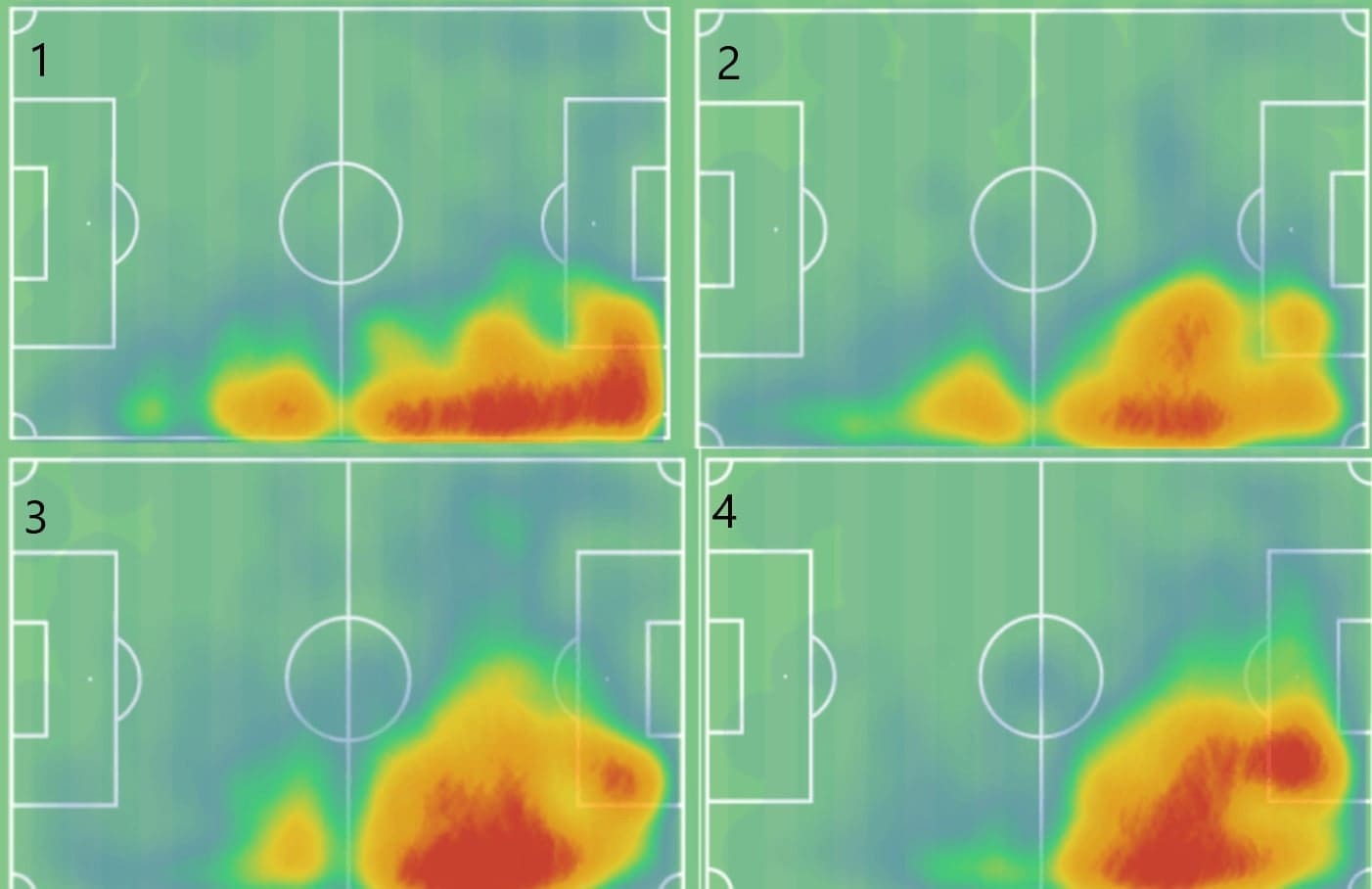
We also compared Costa’s offensive stats with the best wingers in the EFL Championship. As shown in this scatter diagram, Costa’s figure in terms of touches in the box per 90 was outstanding (4.69), higher than his counterparts. However, these touches might not be converting into goal opportunities as his xG per game was 0.19 only, just right at the average point.
When mentioning a left-footed right-winger, we might immediately think of prolific wingers like Arjen Robben and Salah. However, as shown by the heat maps and these stats, the job of Costa was a bit different from them.
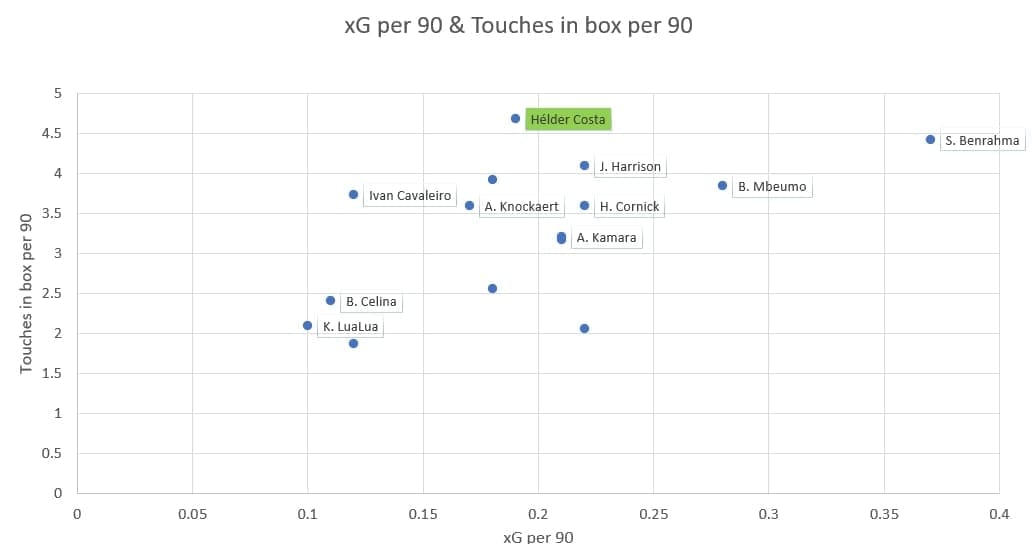
Tactical role under Bielsa
As shown by our previous analysis on the wide rotations of Leeds, Costa was a part of this, and his movements were important to improve the fluidity of the team. Also, since Leeds paid less emphasis at the centre, Costa was vital to the ball progression of the team in the wide areas.
When Costa dropped, he pulled the left-back out and disrupted the opponents’ shape. This created rooms for the rest of the right-back to carry the ball forward, or, Patrick Bamford will exploit spaces created behind the left-back, as a target for the long balls.
This image shows the function of Costa. When he dropped deep, he pulled the left-back out. With a simple one-two, he released Stuart Dallas who will run at the half-spaces. If no options available, Costa would take on the opponents and carry the ball forward to higher areas.
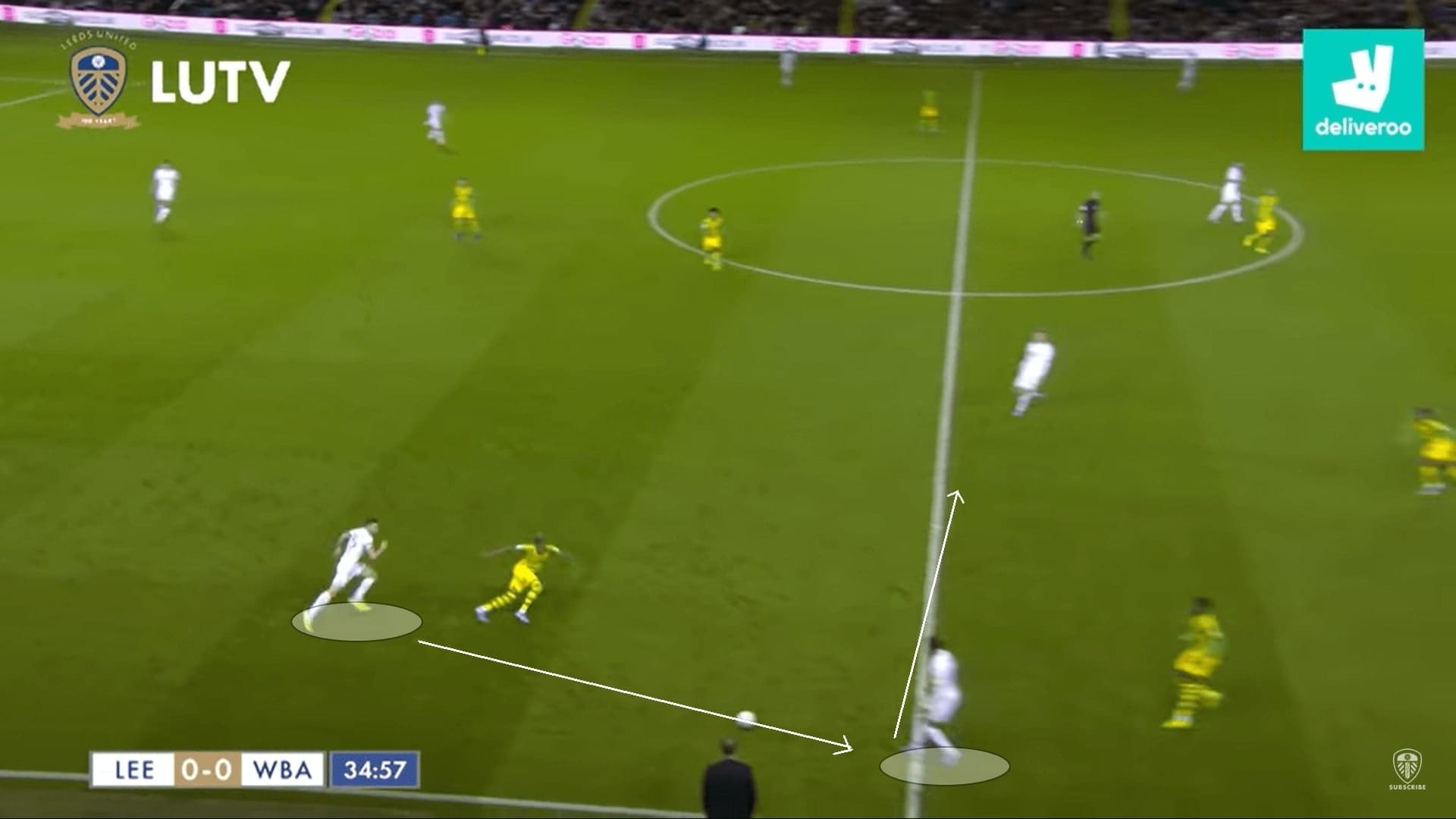
Costa also injected pace to the team, he was quick, hence, possessed the ability to provide the height of the team’s attack. When the opposition tried to defend with a high line, this would be the chance for Costa to run behind them. The impact of this movement was maximized when Bamford dropped to pull the defence out. Since Costa was running in the opposite direction with pace, he was more difficult to track.
The variations of the rotations were discussed in our previous analysis. What Costa offered was the flexibility and fluidity for the rotation. In this example, Costa utilized the dropping behaviour of Bamford to exploit the high defensive line of West Bromwich Albion.
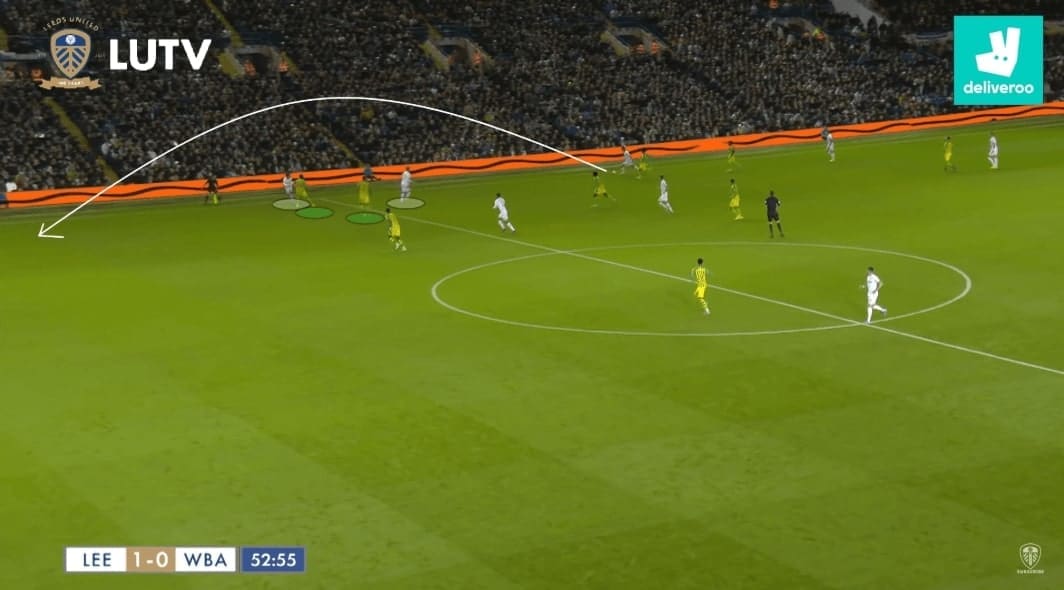
The electric pace of Costa was also useful during the offensive transitions. You would always notice his presence no matter he was the ball-carrier or not. Also, accelerating in an instant to sprint was also a strength of Costa, this helped him to arrive the space earlier than the opponent.
Because of the pace of Costa, he was more unpredictable against an exposed defensive line. As shown in this image, the Birmingham defender was defending deeper as Costa was not there yet. However, this was an advantage for Costa as he had two options. First, if the ball were further progressed by Jack Harrison or it was distributed to the other side of the pitch, Costa could stay on the blindside of the defender and tried to meet the cross. Or, just like in the reality, Costa accelerated suddenly and exploited spaces behind the defence, and scored the goal in a 1 v 1 against the keeper
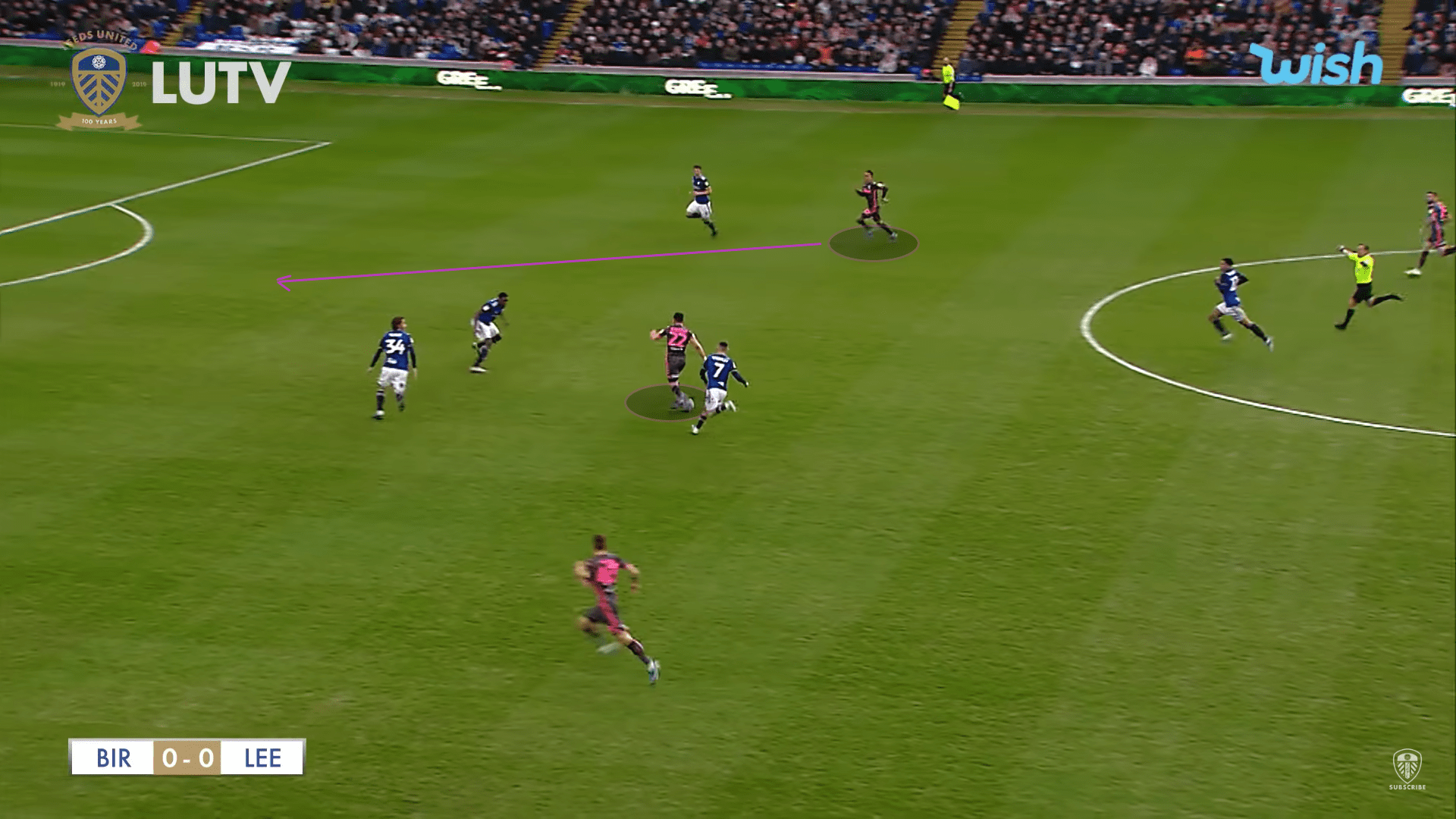
Wide positioning
The positioning of Costa was very wide in many phases of the game. This was beneficial to the team and himself, respectively. Since the winger was almost reaching the touchline, the left-back was less likely to mark him or else he had to sacrifice the defensive shape. If he was marked by the left-back, that means the defence was stretched and horizontal gaps appeared between defenders. To sum up, the wide positioning either helped his team to penetrate vertically or created spaces for the player to receive the ball.
The below image is an example. As Costa positioned himself very wide, he maintained distances with the left-back to receive the ball. After that, he had plenty of spaces to carry the ball forward.
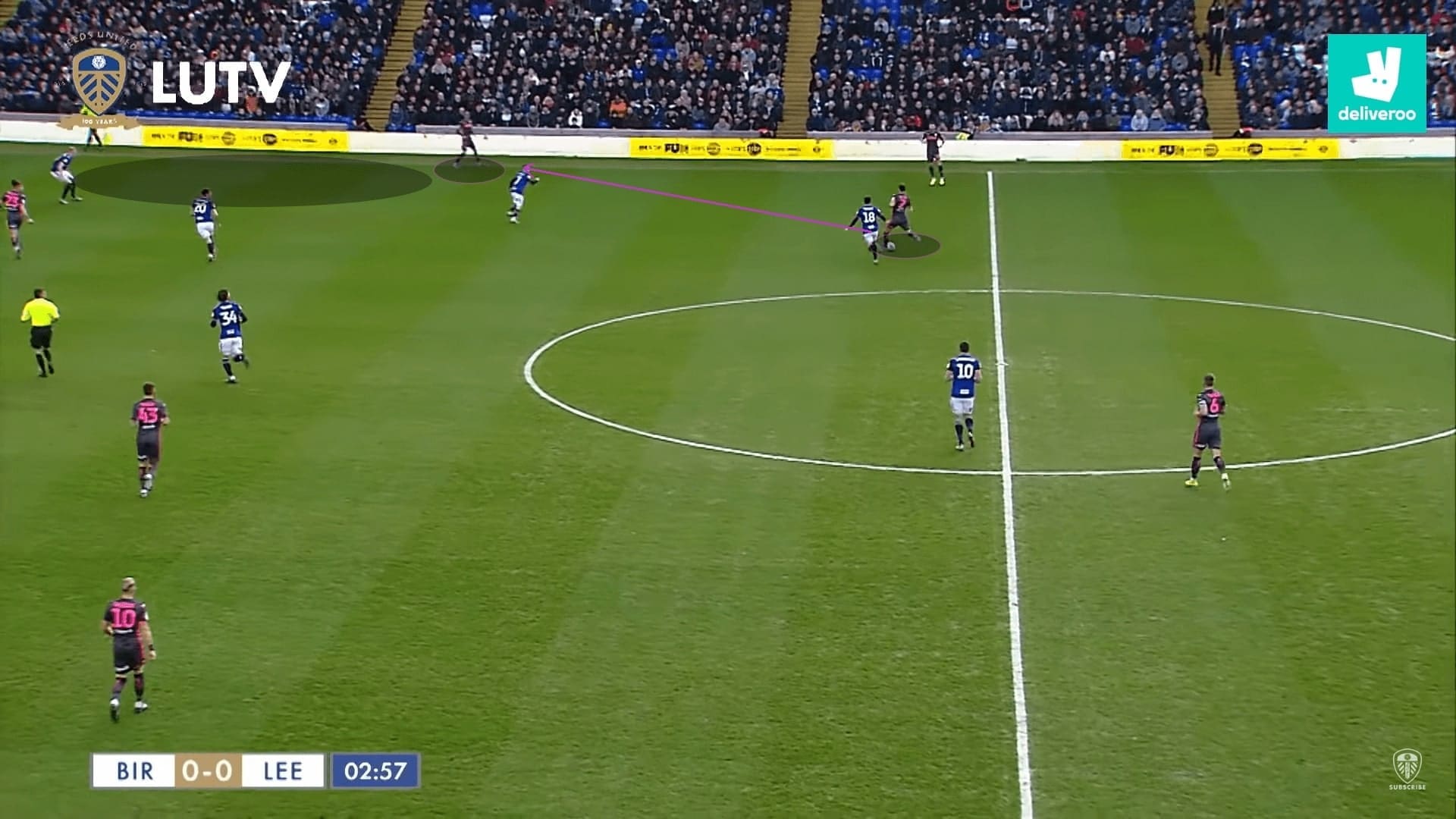
When facing a low block, Costa was more likely to drop instead of attempting to run behind the defence with his pace. He wanted to get touches on the ball. This movement created spaces for himself to receive the ball, so he had the room to exercise his 1 v 1 ability which we will explain later.
In this scenario, you could see Birmingham set a low block with the defence placing themselves at the edge of the box. Instead of running behind the left-back, Costa came out to receive the pass from Dallas. This allowed him to have plenty of spaces and the ground pass was easier to control.
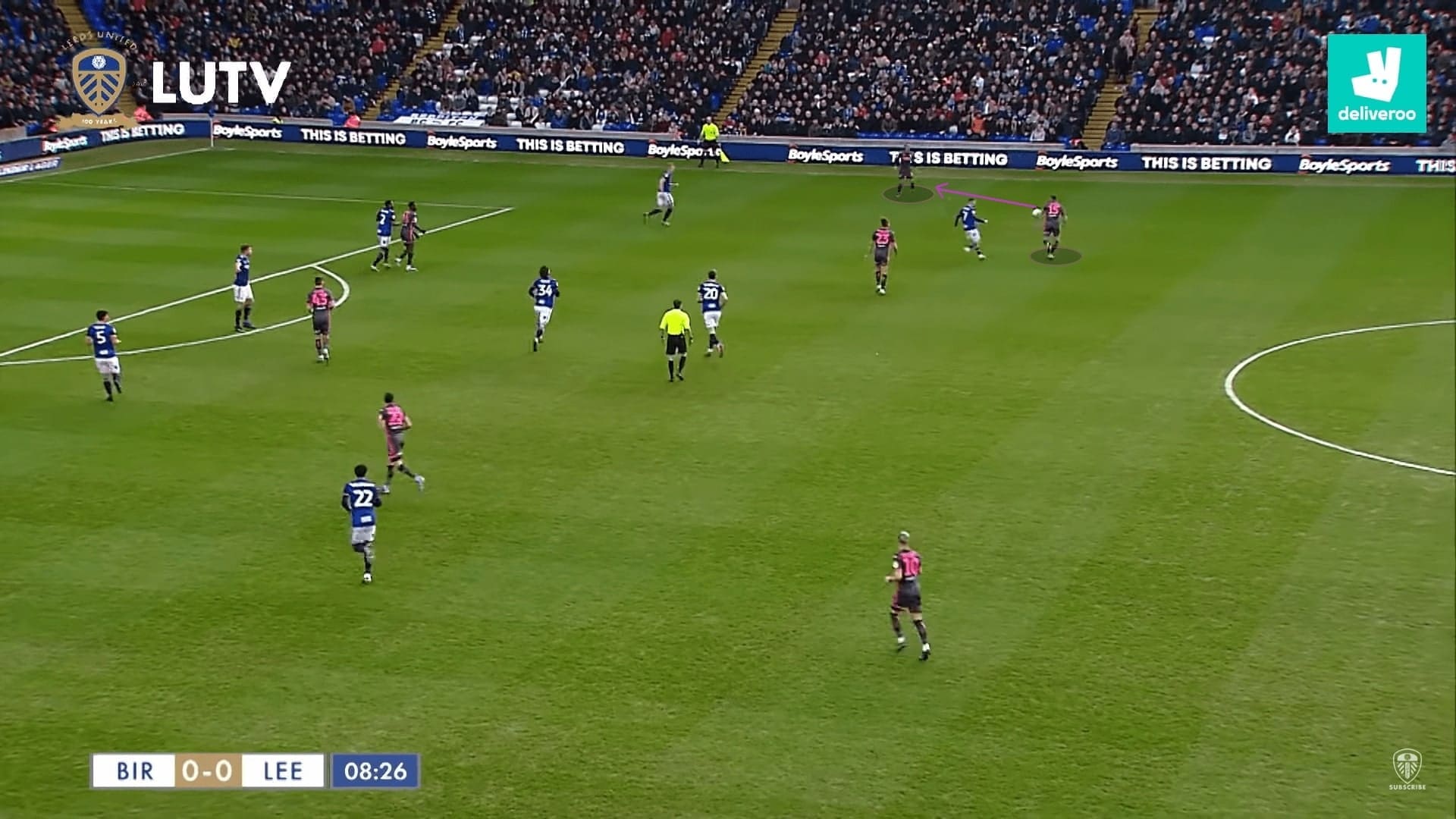
Space creation and 1 v 1 ability
Because Costa was good at dribbling and he was quick, the opposition would want to close him down as soon as he gets the ball. Although his 6.61 dribbles per game were the average of the league, his success rate of 55.28% was slightly high than the league average. Some opponents felt that Costa should be marked by two players, in these cases, the winger pulled spaces for his teammates.
Of course, without an appropriate way to escape from the pressure, creating spaces was useless. This was the value of Costa, as he possessed physical quality: good body coordination, softness and flexibility, distances footsteps were small and quick, he could execute a pass very fast. This was the escape route to find the free player.
The screenshot below summarizes different elements of Costa’s strengths. Because of his wide positioning and pace, he took two Birmingham players to the wide areas. This opened the half-spaces for Luke Ayling to run into. The Leeds right-winger quickly used his quick footsteps to cleverly pass the ball with his outside of the boot. This released Ayling to cross.
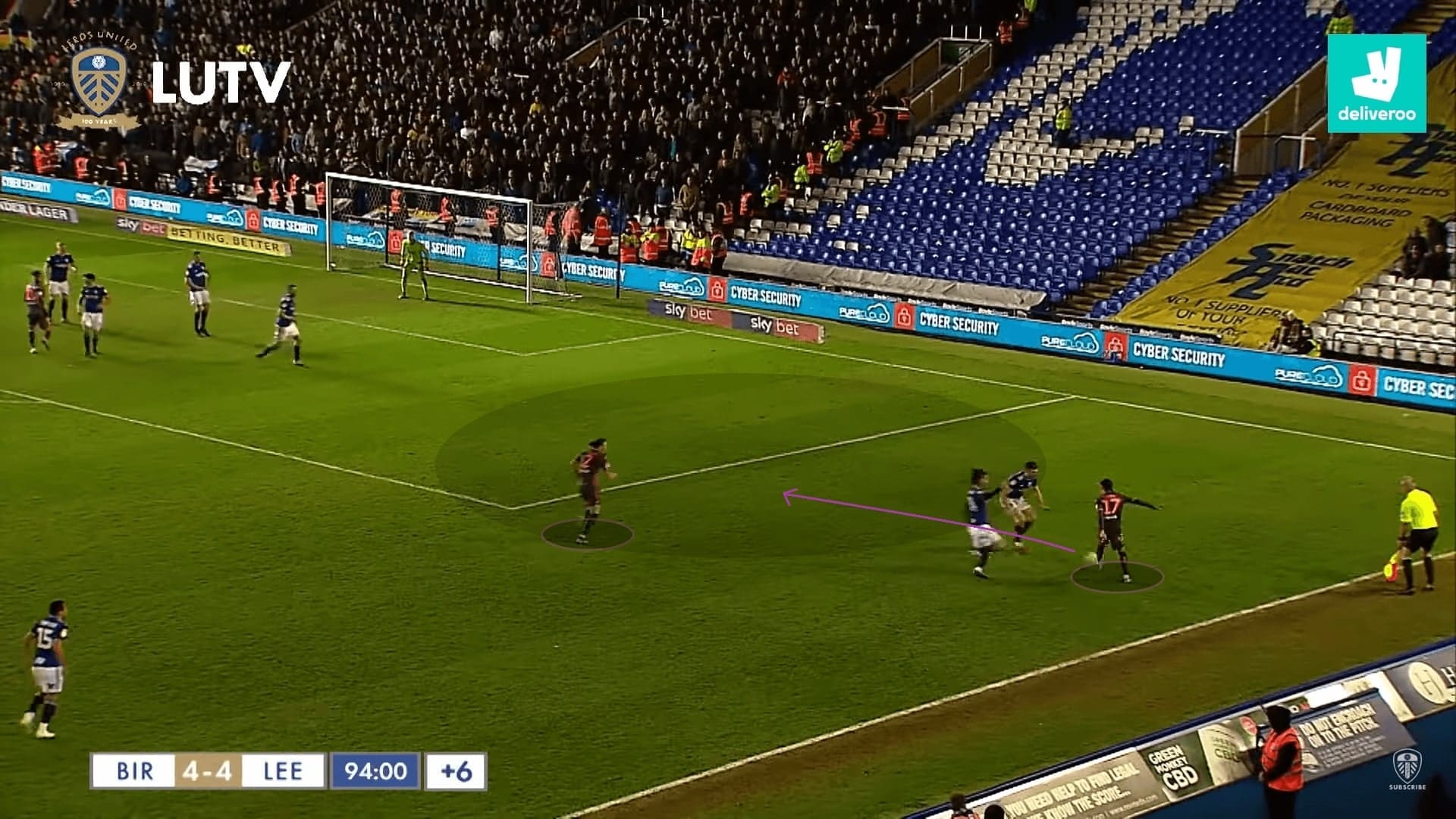
As mentioned, because of his pace, even the opponent only placed one player to approach Costa initially, they would need another one after the first was beaten. Therefore, when Costa was carrying the ball, the passing lane was opened and spaces were generated as the opponent must come and stop him.
In the below image, Costa already dribbled past the first player and he was reaching the byline. This forced the second Middlesbrough player left his target to approach him. As a result, Leeds occupied the right half-spaces.
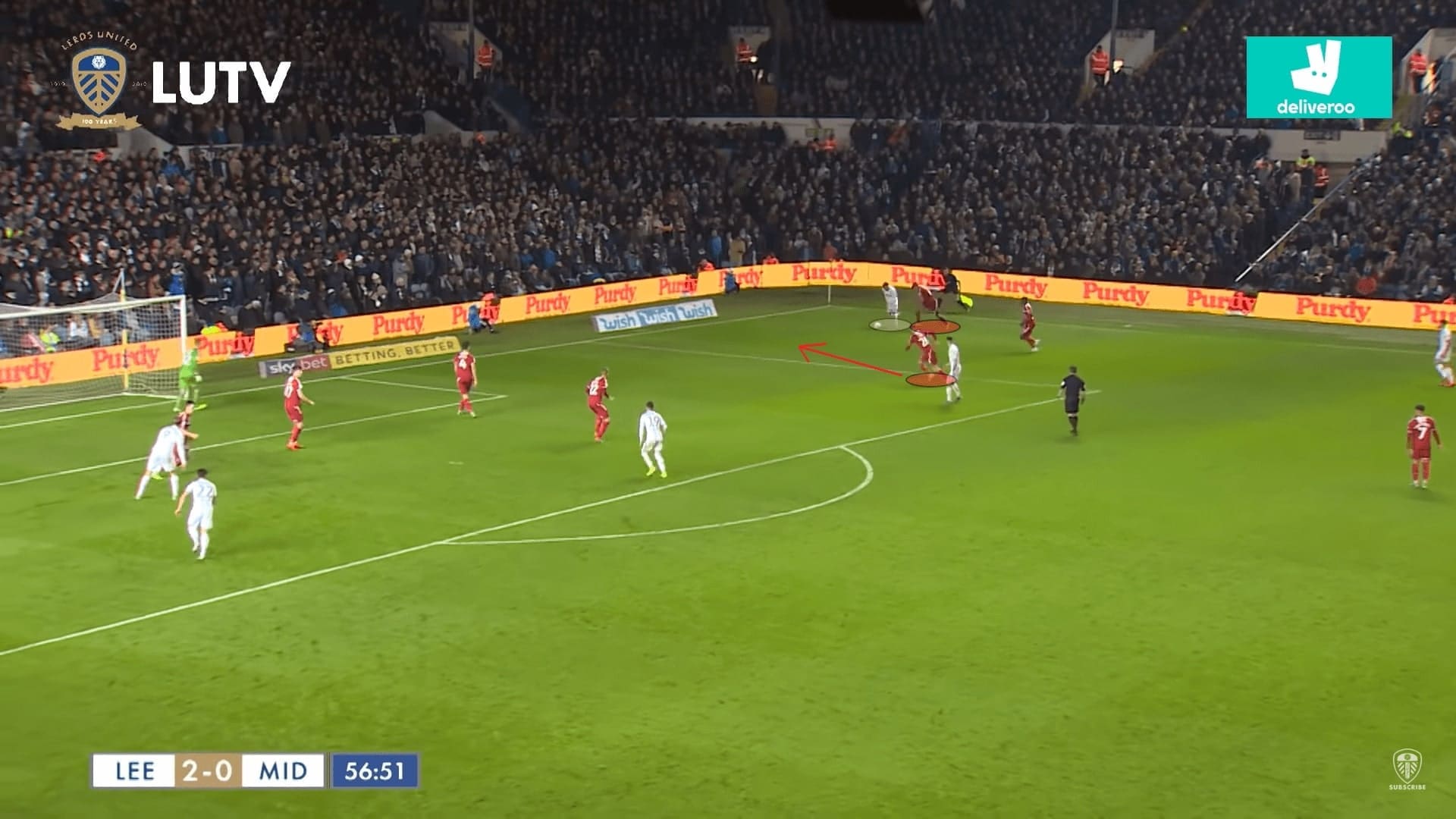
Defensive contribution
As shown in the previous sections, we understood the offensive ability and what could he offer to the team. However, he was also committed to his defensive duties and helped his right-back a lot. These contributions were not quantified, but when watching the game, you could see Costa was always there.
The first example we show was a classic defensive work of a winger: tracking the wide player. It was impressive as this occurred in different phases of the game, even during the transitions, Costa was still willing to join the defence and cover his right-back.
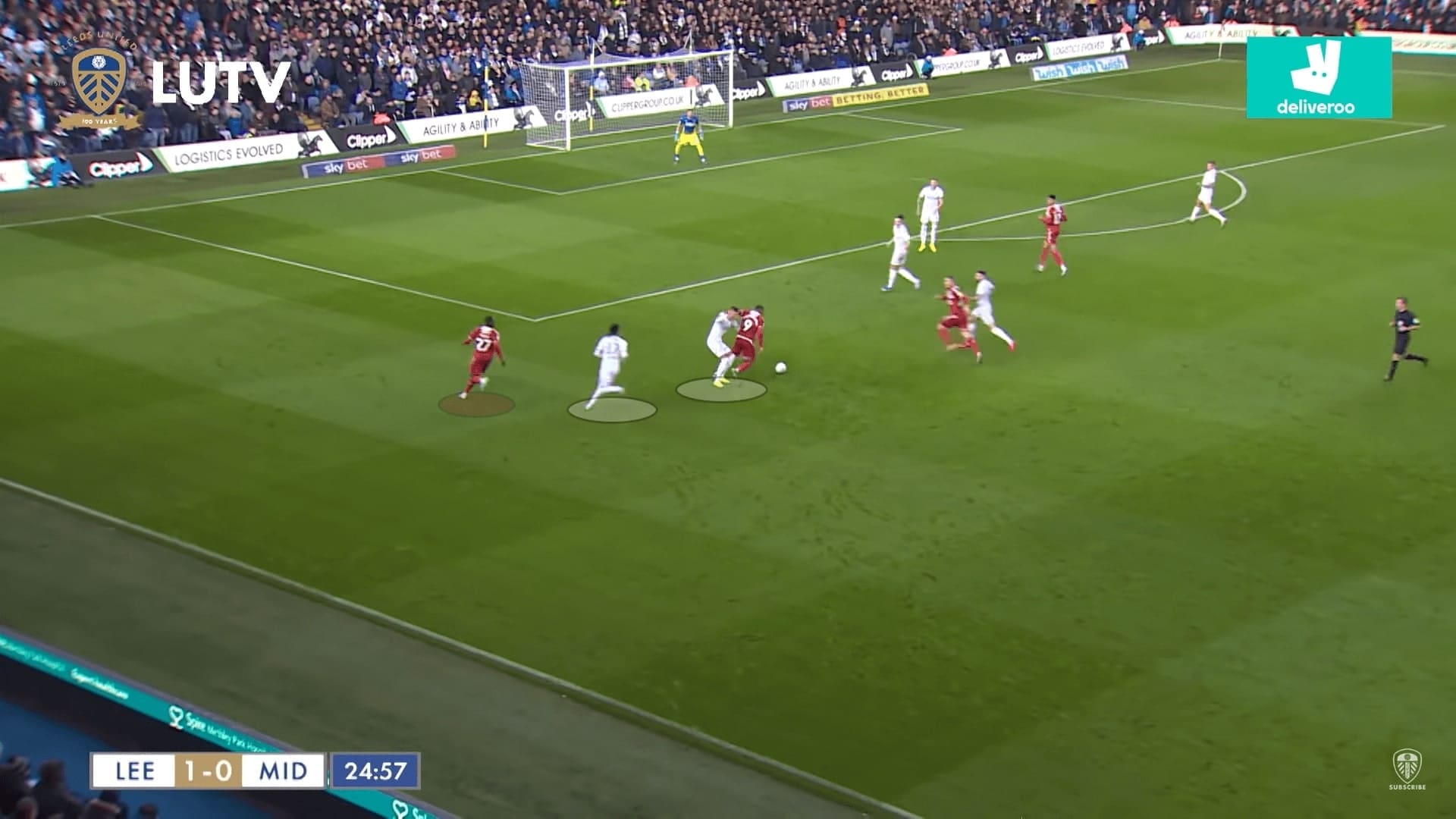
Since Leeds were a team that actively pressing the opponents, the defensive shape was always incomplete. Therefore, cover and balance of players were important to close the gaps. Costa did a huge part to cover the right flank when the right-back: Ayling/Dallas left his position. This largely controlled the left-back or left wing-back of the opposition and minimized their threat.
The defence of Costa was impressive as he was not just merely showing up. Instead, he had a good mindset, protected the area instead of marking the individual. This was done by covering deep, even reaching the same line of Leeds’ defence.
The following image illustrated the defensive effort of Costa, he went very deep to protect the zone first. At least the wide player of Birmingham would catch his attention when travelling to that zone. If he did not, then, Costa also had time to approach and press the wide defender if needed.
A small flaw which was shown in this image was his body orientation. He was too focused on the ball. If the opposition left-back was quick and clever, he could run behind Costa from his blindside.
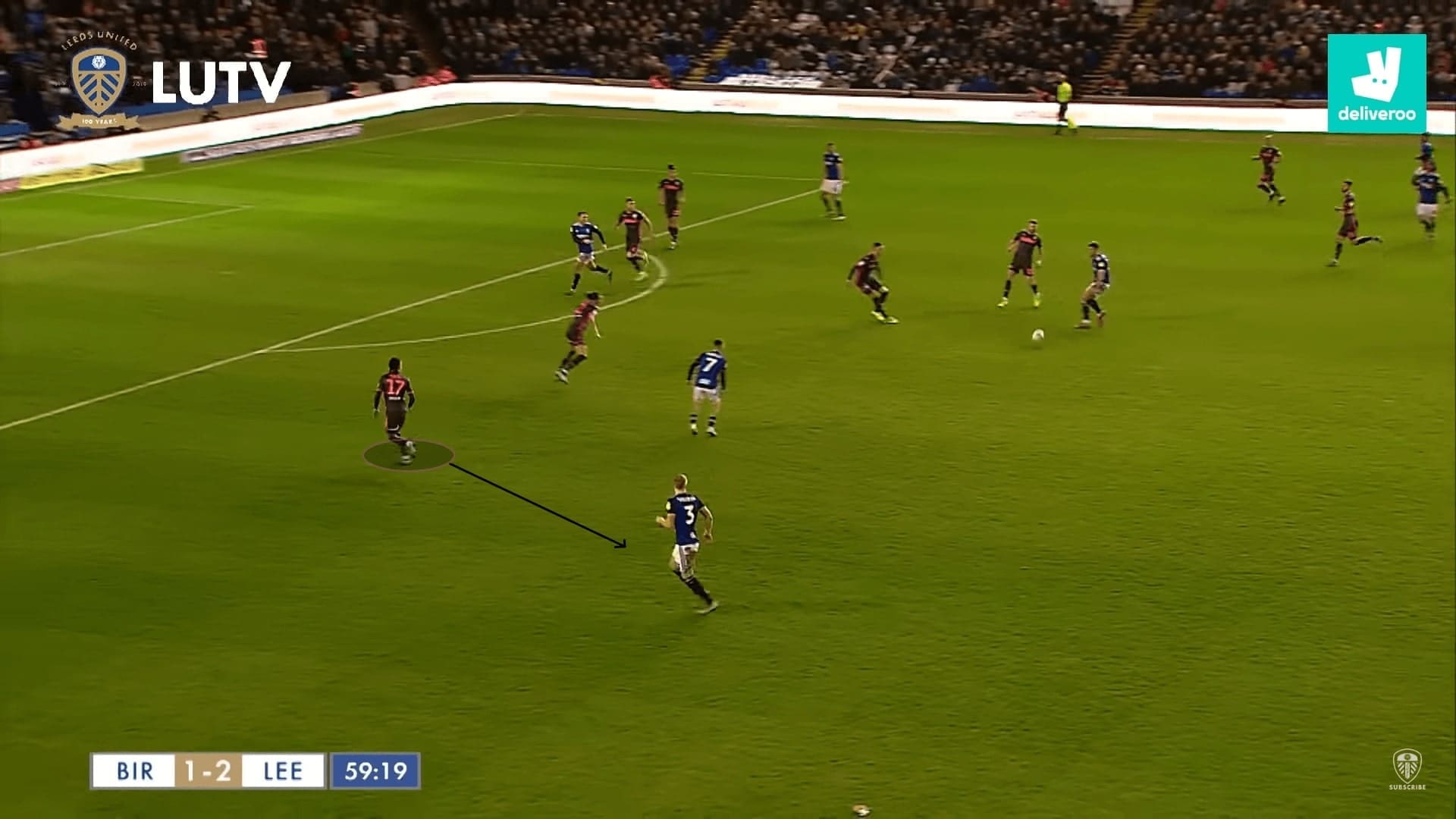
Room for improvement
Costa was a player that always requesting for the ball. He had the physical superiority, he was quick, but sometimes these were not beneficial to the development of the player. The playing style of Costa was relying on getting the ball, hence, his movements were suboptimal because of the above qualities.
Costa made the run because he wanted to get on the ball, but sometimes he should serve the greater good or run to help his teammates. Taking the below image as an example, Costa demonstrated good space recognition by running according to the white arrow with pace. However, given there was another option (the black route), the decision of Costa was suboptimal because of the following. First, he stayed in the sight of the Boro players, so he was easily tracked even being released by Bamford. Second, running closer to Bamford also invited pressure to the flank, the attack would be trapped here.
By contrast, taking the black route helped Costa to stay on the defenders’ blindsides, hence, potentially meeting the cross if the attack was progressed. Also, this generated more spaces for Bamford to escape the pressure.
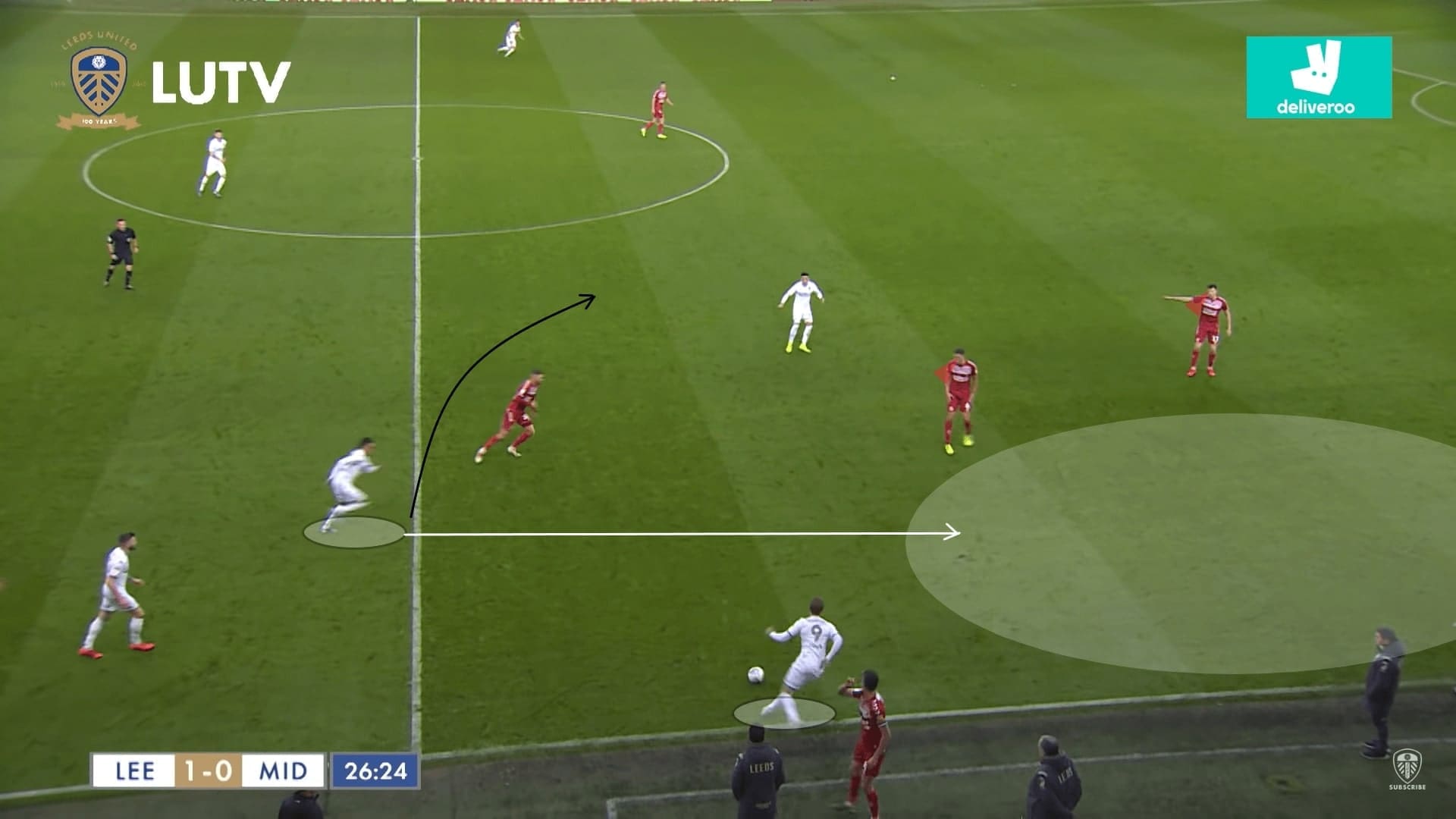
The below example was a similar scenario. Again, Costa came near to the ball because he wanted to take touches. However, this was unwise when there were to West Brom players lurking, the run of Costa reduced rooms of Jamie Shackleton to take touches. The pressure was drawn around the ball and hardly could Leeds progress.
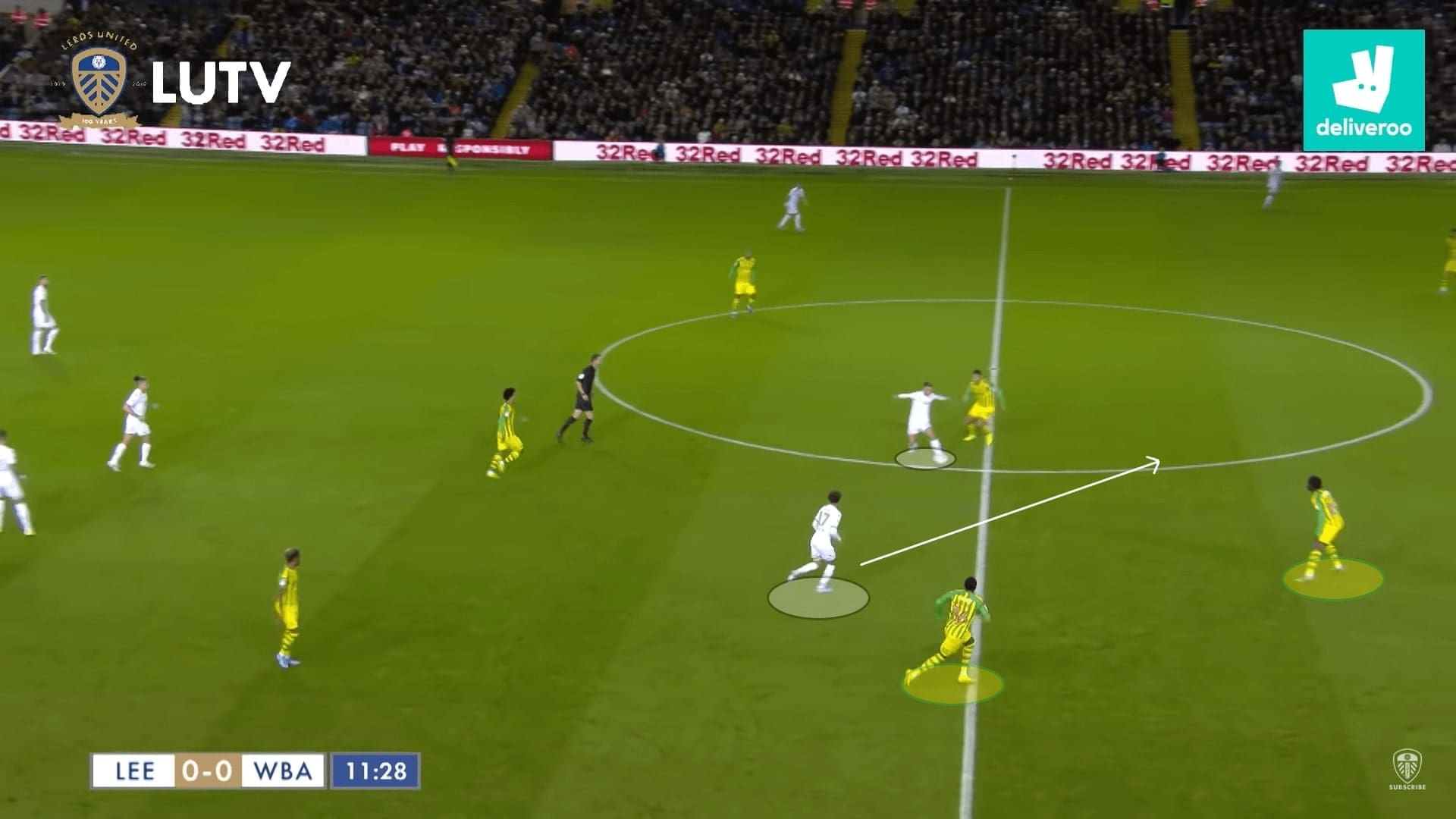
As explained, Costa possessed physical qualities including softness and quick footsteps. This was the reason that he could contact the ball very quickly and change the direction of the ball in an instant. However, when this strength was overused, this was not conducive to the team’s attack. On occasions, Costa was taking too many touches and missed the opportunity for a better decision.
The below scenario is an example. When Leeds regained the ball high, West Brom’s defence was out of shape. Despite Tyler Roberts was free to receive the ball nearby, Costa ignored him and continued to drive the ball forward.
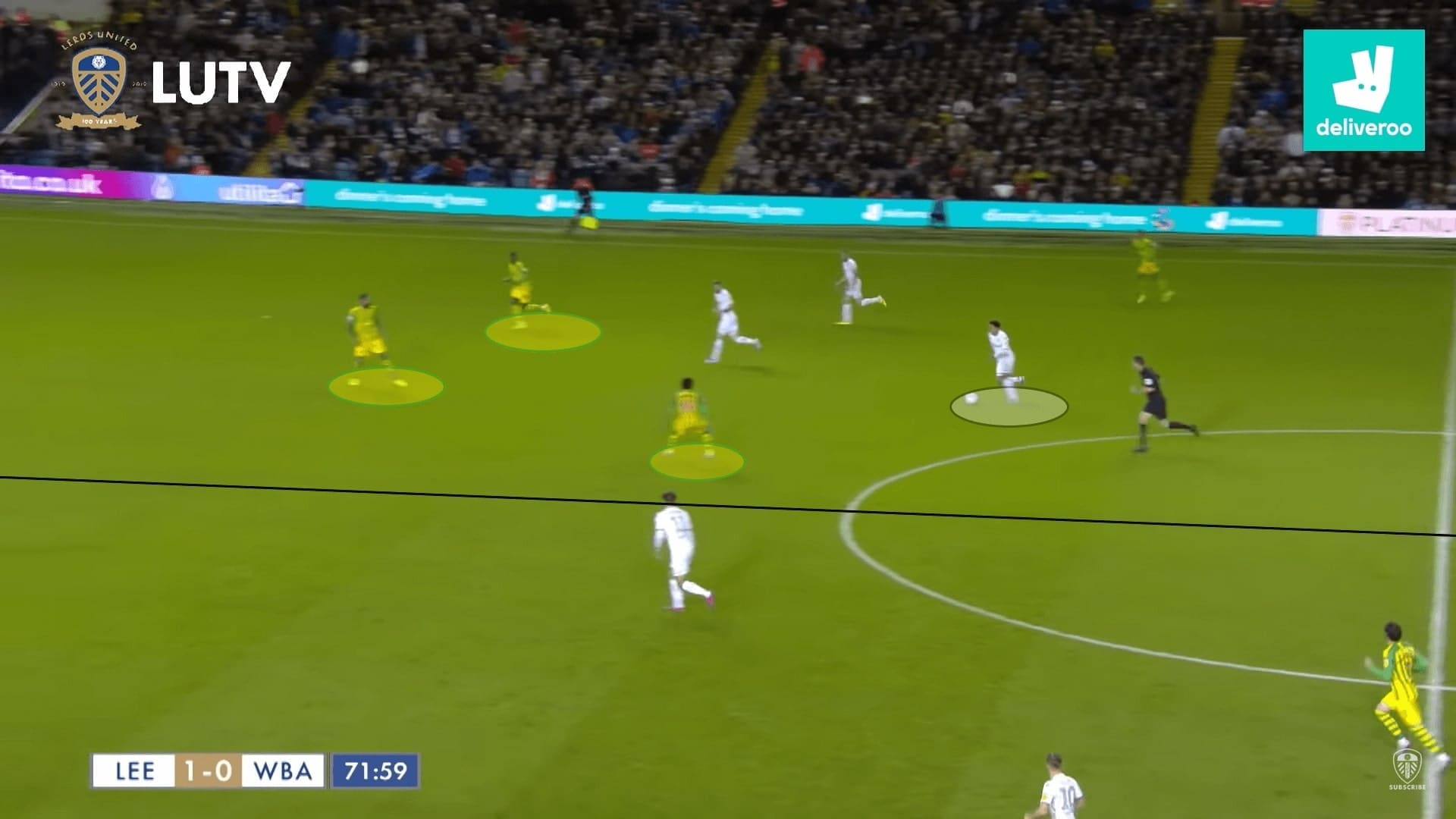
However, as shown by this image, we have a clearer picture of the positionings of the players. Clearly, Lees possessed a numerical superiority on the left, and this could be exploited if Roberts received the ball.
Since Costa continued his dribble, he was fallen into a 3 v 3 situation on the right, and there was no solution for an out-ball. The ball was forced to move wide as a result, and the counter-attack opportunity was ruined.
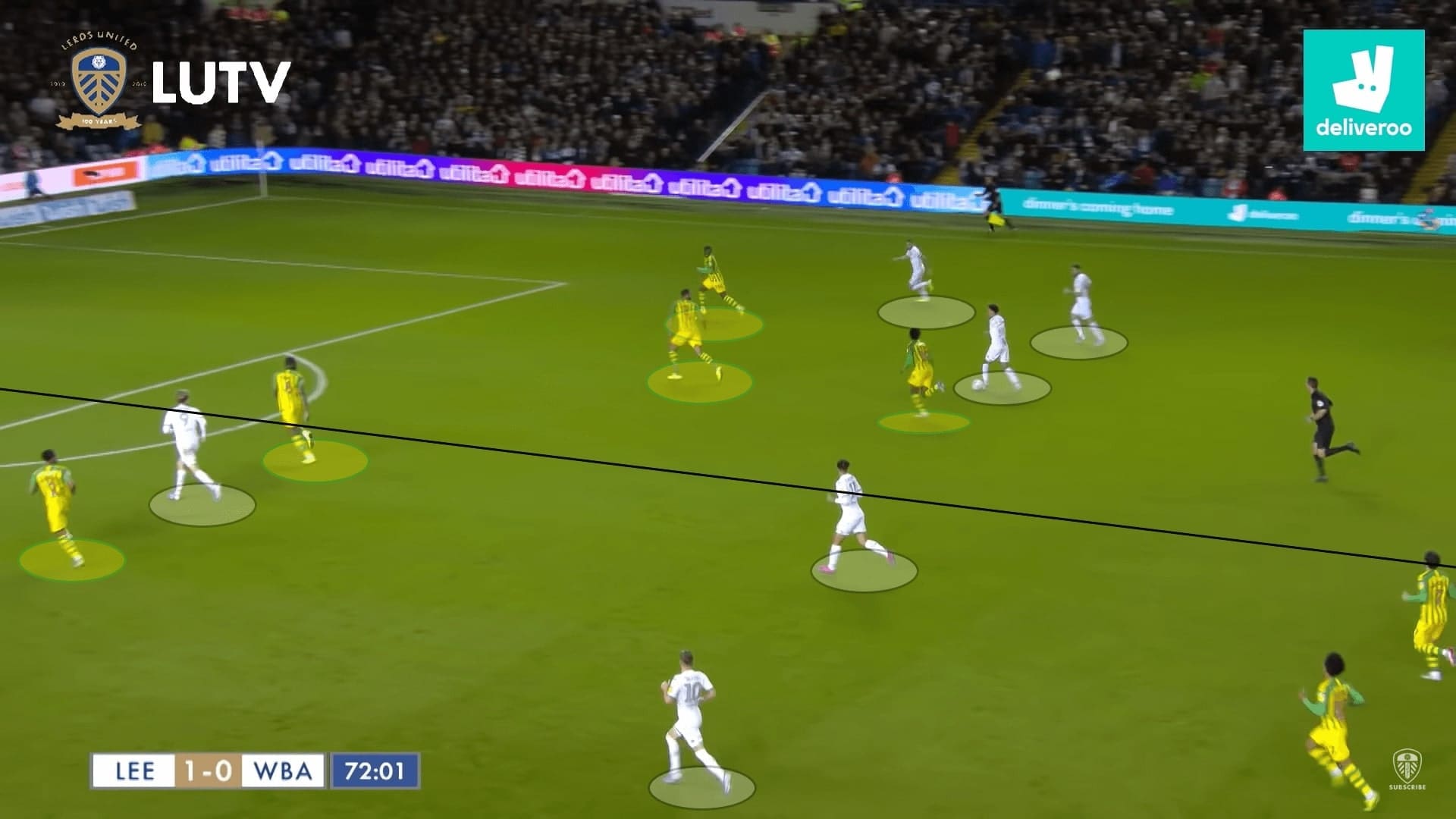
Conclusions
“He is ready, he is prepared. I cannot say I am happy because people will say I’m happy Pablo cannot play!” – Bielsa
Despite being criticized on occasions because of his £15m price tag, Costa was getting better and better. He would be a very good functional player as he could provide the width and height for his team when attacking. Defensively, he was also committed to fulfilling his defensive duties, which eased the burden of the right-back.
Apart from making better movements, Costa also needed better consistency and he should be more clinical. With his 4.69 touches in the box per game, the right-winger should be encouraged to shoot more in the box, in the hopes of making these touches count. It was quite likely that Leeds were purchasing him in the summer, and we will observe how Costa would develop under Bielsa.




Comments